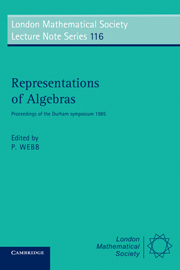Book contents
- Frontmatter
- Contents
- Introduction
- Representation theory of finite-dimensional algebras
- A survey of existence theorems for almost split sequences
- Representations of posets and tame matrix problems
- Geometry of representations of quivers
- Cohen-Macaulay modules on hypersurface singularities
- Almost split sequences and algebraic geometry
- Representation rings of finite groups
Representations of posets and tame matrix problems
Published online by Cambridge University Press: 01 March 2011
- Frontmatter
- Contents
- Introduction
- Representation theory of finite-dimensional algebras
- A survey of existence theorems for almost split sequences
- Representations of posets and tame matrix problems
- Geometry of representations of quivers
- Cohen-Macaulay modules on hypersurface singularities
- Almost split sequences and algebraic geometry
- Representation rings of finite groups
Summary
§ 1. The theory of matrix problems can be considered in a natural way as a part or prolongation of homoiogical algebra (see [1]). Let K be an arbitrary category. Beside the notations Obj K, Mor K, Ind K and K(A,B) generally used for the collections of objects, of morphisms, of isoclasses of indecomposables and of morphisms from A to B(A, B ∈ Obj K), we shall also use the notation El K for the collection of all elements of all objects of K; this makes sense whenever K is a concrete category, i.e. a subcategory of the category of sets.
Let Φ be a functor with values in a concrete category V. To be precise, suppose that Φ depends on two variables belonging to categories K1 and K2 and that it is contravariant in the first and covariant in the second. Then El Φ will denote the collection of all elements of all sets Φ (A,B), where A ∈ Obj K1, and B ∈ Obj K2. With this rather strange terminology, we can say that one of the fundamental ideas of homological algebra consists in the remark that some categories G (of groups, algebras, modules…) can be investigated by means of a naturally constructed map h from El Φ to Obj K, where Φ happens to be one or another appearance of the functor Ext. The map h is surjective if the objects of G are considered up to isomorphisms, but it is far from being injective.
- Type
- Chapter
- Information
- Representations of AlgebrasProceedings of the Durham Symposium 1985, pp. 91 - 108Publisher: Cambridge University PressPrint publication year: 1986

